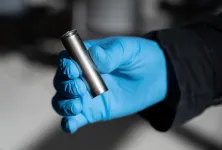3D printing materials for printing aorta model to study optimal CT scanning protocols
This article by Dr. Zhonghua Sun et al. is published in Current Medical Imaging, 2021
2021-03-08
(Press-News.org) Personalised 3D printed models created from cardiac imaging data, mainly from cardiac CT images have been increasingly used in cardiovascular disease, primarily in the preoperative planning and simulation of complex surgical procedures, as well as medical education. 3D printed models are proved to be highly accurate in replicating normal anatomy and cardiac pathology with reported differences less than 0.5 mm between 3D printed models and original sources images. Further to these applications, a new research direction of utilising 3D printed models is to study the optimal CT scanning protocols in cardiovascular disease with the aim of reducing radiation dose while preserving diagnostic image quality. To achieve this goal, an appropriate printing material is essential to ensure that the printed models possess elasticity and flexibility similar to normal tissue properties.
Zhonghua Sun, a John Curtin Distinguished Professor and medical imaging researcher from Curtin University, Australia has been in search of suitable 3D printing materials to print realistic models, and more importantly, to print cardiovascular models with similar tissue properties to replicate heart and aortic arteries. Prof. Sun's research interests lie in 3D image visualization and diagnosis; 3D printing, virtual reality and artificial intelligence in medical applications, specifically in the cardiovascular disease. In his recent work, published in Current Medical Imaging, Prof. Sun and his team presents research findings for printing the aorta models with printing materials having similar CT attenuation to that of normal aortic wall on both pre- and post-contrast CT scans. This study further advances the current applications of 3D printing in cardiovascular disease to another level by presenting evidence that 3D printed personalised aorta models can be used to study optimal CT protocols, in addition to the value that 3D printed aorta models serve as a useful tool for pre-surgical planning and simulation of endovascular repair of aortic disease.
In his latest article, Prof Sun and his team reported findings on how the identified materials can be used to print realistic aorta models. They first created a 25-mm long type B aortic dissection model from CT images, then printed 4 models with use of two materials, namely Agilus from Stratasys and Visijet CE-NT from 3D Systems. These materials are soft and can be mixed with another material such as photopolymer resin to create a range of products with different elastic properties. These 4 aortic models consisted of two Agilus models printed with A40 and A50, representing two different degrees of hardness, another two Visijet models printed with Visijet CE-NT with different hardness, A30 and A70. The Visijet CE-NT A30 has a tensile strength between 0.2 and 0.4 which is close to the aging arteries, while Agilus A40 and A50 have a tensile strength of 0.5 to 1.5. The 4 aorta models were scanned on a 192-slice CT scanner with the standard aorta CTA protocol, and the scans were performed with and without use of contrast medium to measure CT attenuation at true lumen, false lumen, intimal flap and two junction areas between the true and false lumens. Results showed that Agilus models had higher CT attenuation than Visijet CE-NT models on non-contrast CT images, with Agilus A50 having an average CT attenuation similar to that of original CT images. On contrast images, only Visijet CE-NT A30 produced CT attenuation similar to that of original images, while the remaining models printed with other materials resulted in significantly higher CT attenuation than that of original images. This study shows that Visijet CE-NT A30 is considered an appropriate material to print aortic dissection model due to its similar elasticity to the normal aorta.
Aorta CT angiography (CTA) is currently the reference method in preoperative assessment of aortic aneurysm and dissection. Further, CTA is commonly used to follow-up patients treated with endovascular stent grafts. Therefore, regular CTA follow-ups of these patients at 3, 6 and 12 months, yearly thereafter contribute to cumulative radiation dose, which raises serious concerns due to radiation-induced malignancy. Dose optimization is clinically important to these patients receiving multiple CT scans. "3D printed aortic models with Visijet CE-NT material give the appearance of translucent light yellow allowing its use for education purpose, in addition to its reported value in guiding complex aortic surgery or endovascular aortic repair," says Prof. Sun. He also added "printing aortic dissection models is very challenging compared to other cardiovascular models due to very thin membranous structure of the intimal flap." The CTA images used in this study represented nice anatomical structures including intimal flap which were segmented and printed without any difficulty. This confirms the importance of quality of source images to guarantee printing high-quality models.
Prof. Sun's team is continuing to work on printing more anatomical structures including ribs, thoracic vertebrae, soft tissues, lungs and heart which allows for simulation of more realistic environment. "The phantom should be improved to mimic the in vivo circumstance and this allows for investigation of optimal aorta CT scanning protocols for detection of aortic dissection," says Prof. Sun.
INFORMATION:
Find more information about the article from the following link: https://www.eurekaselect.com/191536/article
ELSE PRESS RELEASES FROM THIS DATE:
2021-03-08
A new fabrication technique could allow solid-state automotive lithium-ion batteries to adopt nonflammable ceramic electrolytes using the same production processes as in batteries made with conventional liquid electrolytes.
The melt-infiltration technology developed by materials science researchers at the Georgia Institute of Technology uses electrolyte materials that can be infiltrated into porous yet densely packed, thermally stable electrodes.
The one-step process produces high-density composites based on pressure-less, capillary-driven infiltration of a molten solid electrolyte into porous bodies, including multilayered electrode-separator stacks.
"While the melting point of traditional ...
2021-03-08
You've heard of animals that can lose and then regenerate a tail or limb. But scientists reporting in the journal Current Biology on March 8 have now discovered two species of sacoglossan sea slug that can do even better, shedding and then regenerating a whole new body complete with the heart and other internal organs. The researchers also suggest that the slugs may use the photosynthetic ability of chloroplasts they incorporate from the algae in their diet to survive long enough for regeneration.
"We were surprised to see the head moving just after autotomy," said Sayaka Mitoh of Nara ...
2021-03-08
It's no secret that the United States' $13 billion cannabis industry is big business. Less obvious to many is the environmental toll this booming business is taking, in the form of greenhouse gas emissions from commercial, mostly indoor production.
A new study by Colorado State University researchers provides the most detailed accounting to date of the industry's carbon footprint, a sum around which there is only limited understanding. What is clear, though, is that consumer demand for cannabis is insatiable and shows no signs of stopping as more states sign on to legalization.
The study, ...
2021-03-08
The economic benefits of conserving or restoring natural sites "outweigh" the profit potential of converting them for intensive human use, according to the largest-ever study comparing the value of protecting nature at particular locations with that of exploiting it.
A research team led by the University of Cambridge and the Royal Society for the Protection of Birds (RSPB) analysed dozens of sites - from Kenya to Fiji and China to the UK - across six continents. A previous breakthrough study in 2002 only had information for five sites.
The findings, published in the journal Nature Sustainability, come just weeks after a landmark report by Cambridge Professor Partha Dasgupta called for the value of biodiversity to be placed at the heart of global economics.
For the latest ...
2021-03-08
Coastal populations are experiencing relative sea-level rise up to four times faster than the global average - according to new research from the University of East Anglia.
A new study published today in Nature Climate Change is the first to analyse global sea-level rise combined with measurements of sinking land.
The impact of subsidence combined with sea-level rise has until now been considered a local issue rather than a global one.
But the new study shows that coastal inhabitants are living with an average sea level rise of 7.8 mm - 9.9 mm per year over the past twenty years, compared with a global average rise of 2.6mm a year.
And the impacts are far larger than the global numbers reported ...
2021-03-08
LA JOLLA--(March 8, 2021) Deep learning is a potential tool for scientists to glean more detail from low-resolution images in microscopy, but it's often difficult to gather enough baseline data to train computers in the process. Now, a new method developed by scientists at the Salk Institute could make the technology more accessible--by taking high-resolution images, and artificially degrading them.
The new tool, which the researchers call a "crappifier," could make it significantly easier for scientists to get detailed images of cells or cellular structures that have previously been difficult to observe because they require low-light conditions, such as mitochondria, which can ...
2021-03-08
What The Study Did: Researchers assessed the number of hospital admissions for noncommunicable diseases (abnormal tissue growths, metabolic diseases, cardiovascular diseases and musculoskeletal diseases) in São Paulo, Brazil, between January and June last year compared with the corresponding periods in the previous three years.
Authors: Fernando Adami, Ph.D., of the Laboratório de Epidemiologia e Análise de Dados, Centro Universitário Saúde ABC in São Paulo, Brazil, is the corresponding author.
To access the embargoed study: Visit our For The Media website at this link https://media.jamanetwork.com/
(doi:10.1001/jamanetworkopen.2021.0799)
Editor's Note: Please ...
2021-03-08
Menlo Park, Calif. -- Scientists have taken a major step forward in harnessing machine learning to accelerate the design for better batteries: Instead of using it just to speed up scientific analysis by looking for patterns in data, as researchers generally do, they combined it with knowledge gained from experiments and equations guided by physics to discover and explain a process that shortens the lifetimes of fast-charging lithium-ion batteries.
It was the first time this approach, known as "scientific machine learning," has been applied to battery cycling, said Will Chueh, an associate ...
2021-03-08
Hamilton, ON (March 8, 2021) - Many parents know the struggle of having to make children with pneumonia finish the usual 10-day course in antibiotics despite the child feeling better after a few days of medication.
New research from McMaster University has proven that a five-day course of high-dose amoxicillin will do just as well for children six months to 10 years old with common pneumonia.
"Several studies have proven that adults with pneumonia do fine with short courses of antibiotics, and now we have proved a short course of antibiotics also works for children," said Dr. Jeffrey ...
2021-03-08
A study from North Carolina State University found outdoor play and nature-based activities helped buffer some of the negative mental health impacts of the COVID-19 pandemic for adolescents.
Researchers said the findings, published in the International Journal of Environmental Research and Public Health, point to outdoor play and nature-based activities as a tool to help teenagers cope with major stressors like the COVID-19 pandemic, as well as future natural disasters and other global stressors. Researchers also underscore the mental health implications of restricting outdoor recreation opportunities for adolescents, and the need to increase ...
LAST 30 PRESS RELEASES:
[Press-News.org] 3D printing materials for printing aorta model to study optimal CT scanning protocols
This article by Dr. Zhonghua Sun et al. is published in Current Medical Imaging, 2021


